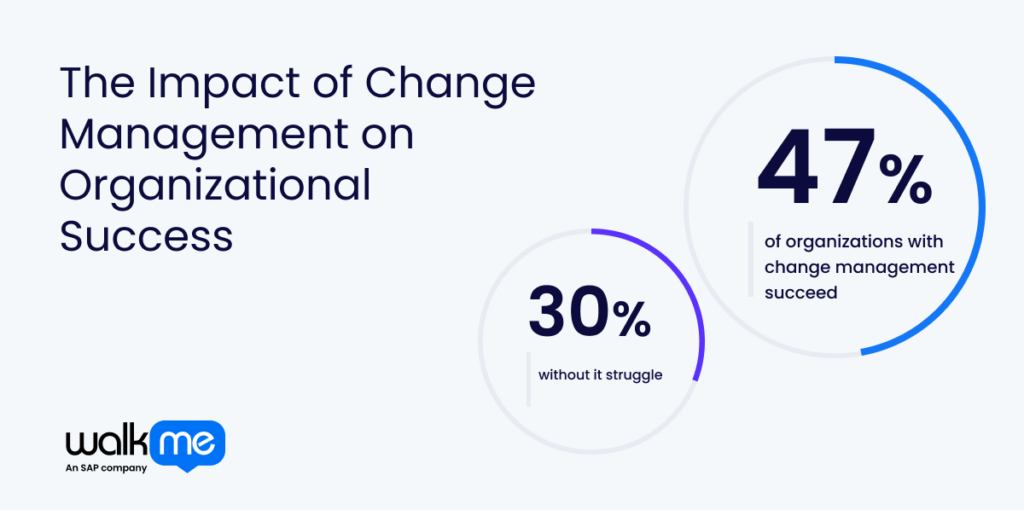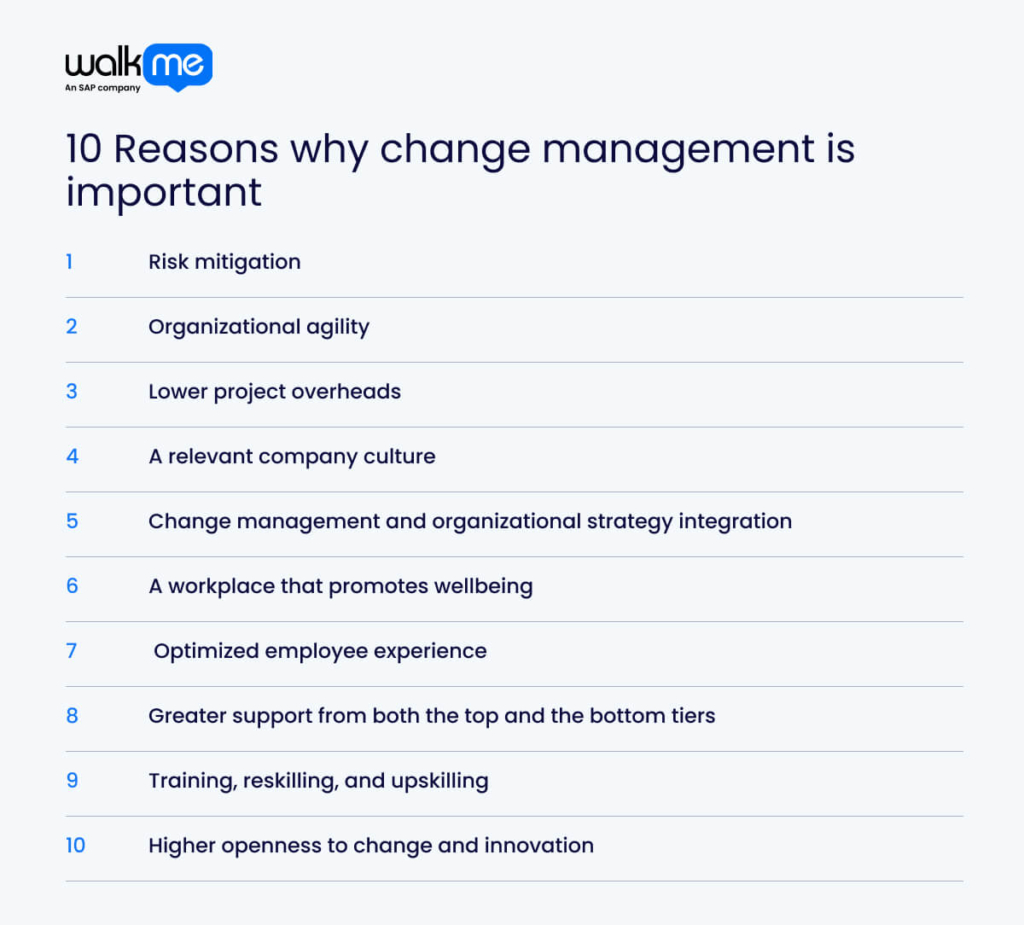Change management matters more than ever in today’s workplace.
47% of organizations that integrate change management are more likely to meet their objectives than the 30% that did not incorporate it. Organizations prioritizing change management are better positioned to navigate transitions successfully and achieve their intended outcomes.

Companies encounter new technology, market shifts, and global issues daily. To stay ahead, they must adapt quickly.
Good change management helps smooth these shifts. It keeps workers on track and productive during big changes. It also allows staff to understand and support new goals.
This can boost morale and help retain top talent. When done right, change efforts lead to better results and make companies more efficient.
Firms that handle change well are more likely to succeed, while those that don’t may fall behind.

This article will explore the top ten reasons why change management is crucial in the modern workplace.
1. Risk mitigation
Change comes with risk, which you must mitigate against to ensure you hit goals and achieve ROI as your transformation succeeds, as it leads to the successful implementation of change with new technologies.
A change management plan allows you to identify the necessary people, systems, and processes to effectively execute revised plans and prepare for the risks of any situation.
It is essential to have a robust change management strategy that prioritizes change requests and identifies the most effective solutions to implement those requests with minimal disruption to reduce resource-related risks while managing change.
The role of change managers is to coordinate a change management strategy for how their organization mitigates these risks using the following techniques: risk assessments, predictive modeling, strategic risk mitigation plans, and responding to problems as they occur.
As with any other business endeavor, it is essential to make calculated, informed decisions around risk to avoid waste throughout all change management processes.
2. Organizational agility
Organizations must become more agile and adapt to marketplace transitions to stay competitive. They can do this by increasing their digital adaptability, responsiveness, and speed to implement organizational change successfully.
This need has driven many organizations to adopt new business models and mindsets to streamline business processes. Three key approaches have emerged: Agile, Lean, and Zero-based mindsets.
Agile focuses on continuous improvement through small changes to software and embracing uncertainty.
Lean emphasizes continuously improving waste reduction and value delivery of expected outcomes.
Zero-based mindsets involve reviewing a company’s ambition, choices, and capabilities without being tied to past approaches.
These methodologies help organizations react both proactively and reactively to external and internal changes, ensuring resilience and sustainability.
3. Lower project overheads
Handling unpredictable changes becomes far more challenging without a proper change management process.
Teams are often forced to adjust on the fly rather than following a structured, pre-established plan. This reactive approach can lead to heightened stress levels, miscommunication, and missed deadlines, ultimately adding unnecessary overhead to projects.
Last-minute changes often create chaos, leaving teams scrambling to adapt, which can result in costly delays and confusion. Implementing a change management process helps mitigate these issues by preparing teams for unexpected changes, ensuring that they know how to handle potential disruptions, such as unforeseen costs or shifting project requirements.
With a structured approach, teams are better equipped to address last-minute changes in an organized, less stressful manner. This leads to smoother project execution, better communication, and a higher likelihood of meeting deadlines and staying on budget.
4. A relevant company culture
Change management helps your company culture to adjust over time and always be relevant to ensure you can attract the best talent and overcome recruitment challenges.
Company culture has far-reaching effects on every aspect of a business. It influences the employee experience, shapes innovation and product development, and impacts productivity and output.
Notably, even seemingly irrelevant change projects such as digital adoption and software implementation can significantly impact company culture. This highlights the pervasive nature of organizational culture and its importance in change management processes.
5. Change management and organizational strategy integration
For organizational strategy to be effective, companies must fully embrace and integrate change management, a principle that holds particularly true today.
Digital innovation, transformation, and change are not occasional events but constant forces shaping the market.
Forward-thinking companies recognize that treating change initiatives as isolated projects is no longer sufficient. Instead, they weave change management into the very fabric of their top-level strategy. This approach ensures the organization is always prepared to adapt, innovate, and respond to new challenges and opportunities.
Strategic integration of change management is crucial for any business aiming to evolve, compete, and thrive.
This approach offers several key benefits. It enables companies to anticipate and respond to market shifts more quickly while promoting a culture of continuous improvement. It also helps align all levels of the organization toward common goals, improving resource allocation and decision-making processes.
6. A workplace that promotes wellbeing
Wellbeing in the workplace goes beyond providing staff with comfortable furniture and adequate financial resources for their roles.
It encompasses a holistic approach to employee satisfaction and growth. A key aspect of this is preparing employees for changes and keeping them stimulated in a manageable and rewarding way.
When implemented thoughtfully, change can be a powerful driver of personal and professional development. According to a recent report, 54% of employees said they encounter stress that helps them thrive. This surprising statistic highlights the potential positive impact of change on your team, provided it’s introduced in a stimulating yet manageable way.
The key lies in striking the right balance. While some levels of stress can be motivating and productivity-enhancing, it’s crucial to avoid overwhelming employees. Change managers must carefully gauge the pace and scope of changes, ensuring they challenge staff without pushing them beyond their coping abilities.
This approach promotes well-being and encourages a more resilient and adaptable workforce.
7. Optimized employee experience
Employee experience is key to how your team views change management’s value.
A supportive, empowering, and celebratory culture creates a positive work environment. This fosters a stronger sense of community, making changes smoother and more lasting.
When staff feel they belong and have strong ties with their teams, they produce higher quality, more thoughtful work. This sense of connection helps them embrace change more readily and contribute more effectively to the organization’s goals.
A positive employee experience during change can significantly benefit an organization in several ways. Employees who feel supported and valued during transitions tend to show higher engagement and motivation. This positive attitude often increases the willingness to adapt to new processes, making the change implementation smoother.
Employees are more likely to collaborate effectively and share knowledge, encouraging a learning environment. A positive experience also reduces resistance to change initiatives, making the process more efficient.
8. Greater support from both the top and the bottom tiers
Change management often leads to more significant support for all tiers of the organization as leaders reimagine hierarchies and the amount of support needed for staff at every level is reviewed and adjusted.
Practical change practitioners recognize the importance of obtaining support from all levels of an organization and its ecosystem. They focus on gaining backing from top-level business leaders, middle managers, and frontline employees and extend their efforts to include partners and vendors.
By aligning the interests of these diverse groups, change practitioners can significantly improve project outcomes.
This approach helps to optimize various aspects of the change initiative, from managing costs to achieving better overall results.
9. Training, reskilling, and upskilling
In addition to long-term career development, there is a growing need for short-term skills training and change management programs.
One example is a digital adoption program focusing on key areas like software implementation, user onboarding, and training. By enhancing change management training, organizations can significantly reduce employees’ time to reach full competency and shorten learning curves.
This accelerates the adoption of new technologies and leads to better employee engagement, less frustration during transitions, and improved productivity. When change is managed effectively, teams can adapt quickly and seamlessly.
Focusing on these short-term training needs ensures companies have a workforce equipped to handle current challenges and future changes.
10. Higher openness to change and innovation
Adapting to market or technology changes is crucial for organizational success. In some cases, change becomes necessary, even if it’s just for the sake of change, especially if the current status quo no longer yields positive results.
Organizational agility allows prompt and innovative responses to market changes and more efficient project management for managers across the organization.
For a company to stay current and ahead in the industry, it’s essential to have both agility and openness. Doing so means quickly embracing new ideas and implementing them to keep up with the changing times.
Use a DAP to show your staff the importance of change management
Change management must be an integral part of the process for organizations to successfully adapt and grow as part of a large-scale organizational change.
You must consider many internal and external factors when developing a sound strategy for large-scale organizational changes.
Taking these into consideration by using a digital adoption platform (DAP) can help communicate the importance of adapting to changes in the corporate environment to your staff as you implement change.
It can also give them the tools for long-lasting transitions using in-app guidance and personalized training.
Change itself is inevitable, and for a company to thrive, it must learn how to manage change effectively for organizational success.
FAQs
Change management theory is crucial because it provides a structured approach to transitioning individuals, teams, and organizations. It minimizes disruption, improves the adoption of new processes, and ensures changes are implemented effectively, resulting in better outcomes and higher productivity.
Change management ensures that all modifications to processes, systems, or policies are handled systematically. This minimizes risks, ensures regulatory compliance, and helps maintain continuity while implementing improvements or necessary changes.
Change control management is important because it ensures that any changes to a project or system are evaluated, documented, and approved systematically. This reduces errors, prevents disruptions, and maintains the quality and integrity of the project or product.

